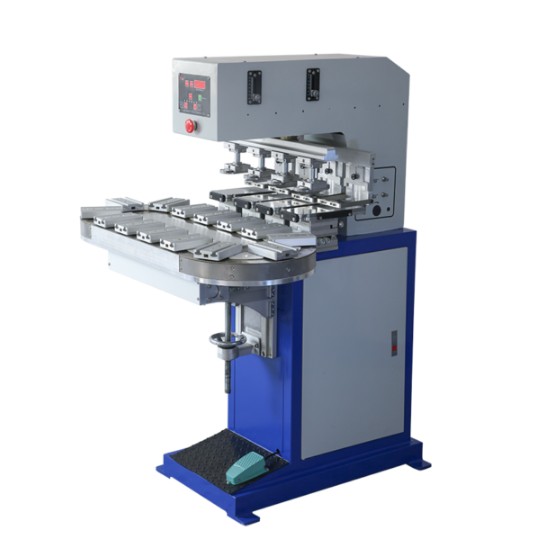In today’s fast-paced world, efficient and high-quality printing is essential in various industries. One of the most popular printing methods is pad printing, which involves the transfer of ink from a printing plate to a substrate using a silicone pad. Pad printers are machines designed specifically for this process, and they have made printing efficient and straightforward in several ways.
Pad printing machine manufacturers offer a range of pad printing equipment for sale. Depending on the printing requirements, these machines come in different sizes and configurations. The pad printing process is easy to understand and involves the following steps:
Artwork preparation: The artwork is prepared using specialized software and transferred onto a printing plate. The printing plate is made of metal or polymer and contains the image to be published.
Ink preparation: The ink is prepared according to the substrate and the image to be printed. Different inks are used for printing on other materials, and the ink viscosity is adjusted to achieve the desired print quality.
Printing: The pad printer picks up the ink from the printing plate and transfers it to the substrate using a silicone pad. The pad conforms to the shape of the substrate, allowing for accurate and precise printing.
The pad printer is an essential component of the pad printing process. Several members work together to transfer the ink from the printing plate to the substrate. The main features of a pad printer are:
Printing plate: The printing plate contains the image to be printed. It is made of metal or polymer and is mounted on the pad printer.
Ink cup: The ink cup holds the ink and is positioned above the printing plate. The ink cup is sealed to prevent evaporation and contamination of the ink.
Silicone pad: The silicone pad picks up the ink from the printing plate and transfers it to the substrate. The pillow conforms to the shape of the substrate, ensuring accurate and precise printing.
The pad holder holds the silicone pad and positions it above the substrate.
Printing table: The printing table holds the substrate and moves it into position for printing.
Now let’s explore how to pad printers make printing efficient and straightforward in more detail.
Versatility
Pad printers can print on various surfaces, including flat, curved, and irregular shapes. This makes them suitable for printing on multiple products, from promotional items to industrial components. With pad printing, printing on materials such as plastic, glass, ceramics, and metal is possible. Pad printers also allow for multi-colour printing, making printing complex images and designs possible.
Speed
Pad printers can print at high speeds, making them ideal for mass production. The printing process is also automated, reducing the need for manual labour and increasing efficiency. Pad printers can print up to 1200 cycles per hour, depending on the machine’s configuration and the printing requirements. The high-speed printing capability of pad printers allows quick turnaround times, making them a popular choice for printing on demand.
Accuracy
Pad printers can produce high-quality prints with precise registration. The silicone pad conforms to the shape of the substrate, ensuring that the image is printed accurately. The ink deposition is uniform, ensuring consistent print quality. With pad printing, it is possible to publish photos with fine details and small text, making it a popular choice for printing logos and branding materials.
Cost-effectiveness
Pad printing is cost-effective, especially for small to medium-sized print runs. The equipment is relatively affordable, and the ink consumption is low. The printing plates used in pad printing are durable and can be used for a long time, reducing the need for frequent plate changes. The ink cups used in pad printing are also designed to minimize ink wastage, reducing printing costs.
Ease of Use
Pad printers are easy to use and require minimal training. The printing process is automated, reducing the need for manual intervention. The machines are designed to be user-friendly, with intuitive controls and easy-to-follow instructions. Pad printers also require minimal maintenance, further reducing operational costs.
Customization
Pad printers offer a high degree of customization, allowing for the printing of unique designs and logos. The printing plates can be easily changed, making printing different images and designs possible without needing a separate machine. This flexibility makes pad printers popular for businesses looking to customize their products with branding and promotional materials.
Durability
Pad printers are built to last, with robust construction and durable components. The machines are designed to withstand the rigours of industrial use and can operate for extended periods without a break. The printing plates used in pad printing are also durable and can be used for thousands of cycles before needing to be replaced. The durability of pad printers makes them a reliable choice for businesses investing in printing equipment.
Conclusion
Pad printers have made printing efficient and straightforward in several ways. They offer versatility, speed, accuracy, cost-effectiveness, ease of use, customization, and durability, making them an essential component of various industries. Pad printing machine manufacturers offer a range of equipment for sale, ensuring that businesses of all sizes can invest in printing equipment that meets their specific requirements. Whether you’re printing logos on promotional items or branding materials on industrial components, pad printers offer a reliable and cost-effective solution.







